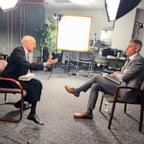New Treasury plan aims to trigger $1 trillion in lending
WASHINGTON -- Treasury Secretary Timothy Geithner today unveiled a sweeping plan to shore up the financial system that could deliver more than $1 trillion as the government works with the private sector to buy troubled assets from lenders, make bank capital injections and expand a Fed lending program.
Treasury wants to use federal funds as seed money to induce the private sector to buy bad assets. The government will create a public-private entity that could buy up to $500 billion in toxic assets. The government could also absorb, or guarantee, part of the losses from bad assets held by financial firms.
The renamed "Financial Stability Plan," rolled out by Geithner, will also use at least $50 billion of the remaining $350 billion from last year's financial rescue law to help prevent home foreclosures. Details of that plan will be announced "in the next few weeks," Geithner said.
The administration will also use $100 billion to expand a recently-created $200 billion Federal Reserve program. That program, designed to bolster lending for student loans, credit cards and auto loans, will also cover bonds backed by commercial real estate and privately issued mortgage-backed securities. The new funding is designed to leverage hundreds of billions of additional activity under the Fed program.
Banks could receive more capital under the plan, which will be funded from the remaining $350 billion of last year's $700 billion financial rescue plan. But to get aid, banks would be subject to beefed up supervision or stress testing, especially big banks.
Here's how Geithner laid out three key elements of the plan Tuesday:
• "First, we're going to require banking institutions to go through a carefully designed comprehensive stress test ... We want their balance sheets cleaner, and stronger. And we are going to help this process by providing a new program of capital support for those institutions which need it...
"Those institutions that need additional capital will be able to access a new funding mechanism that uses funds from the Treasury as a bridge to private capital. The capital will come with conditions to help ensure that every dollar of assistance is used to generate a level of lending greater than what would have been possible in the absence of government support. And this assistance will come with terms that should encourage the institutions to replace public assistance with private capital as soon as that is possible.



